De Havilland DHC-3 Otter and De Havilland DHC-2 Beaver
Taquan Air and Mountain Air Service LLC
Near Ketchikan, Alaska
May 13, 2019
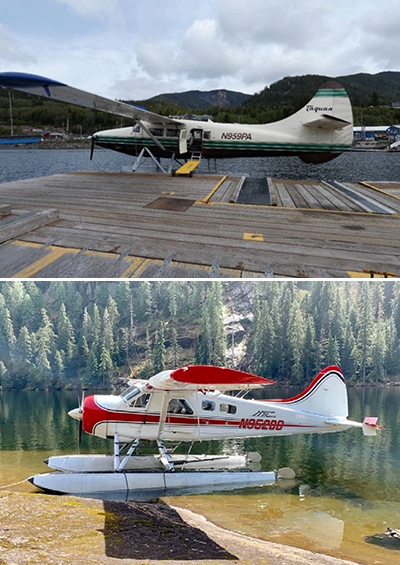
At 1221 Alaska daylight time on May 13, 2019, a de Havilland DHC-3 Otter floatplane equipped with Automatic Dependent Surveillance-Broadcast (ADS-B) collided with a de Havilland DHC-2 Beaver floatplane, also equipped with ADS-B. The collision occurred at 3,350 feet mean sea level (msl) over George Inlet in southeastern Alaska, eight miles north of Ketchikan, in daytime Visual Flight Rules (VFR) conditions.
The accident occurred when the two 14 CFR Part 135 on-demand sightseeing airplanes collided en route to a scenic waterfall near Mahoney Lake an area with a high concentration of air tour airplanes. The pilot and four passengers on the Beaver were fatally injured when the airplane broke up inflight following the collision. The Otter, with a pilot and ten passengers onboard, remained intact after the collision, reversed course, and crashed into George Inlet approximately one minute later. The Otter pilot was able to slow the airplane’s descent rate; however, the Otter flipped over upon hitting the water. The pilot and nine passengers were able to swim free of the wreckage. The passenger sitting in the right front seat did not survive.
The NTSB determined that the accident was caused primarily by the inherent limitations in the see-and-avoid concept that pilots must use to maintain separation with other airplanes, as well as the absence of visual and aural alerts from the onboard ADS-B traffic display technologies.
NTSB accident report: CEN19MA141
History of Flights
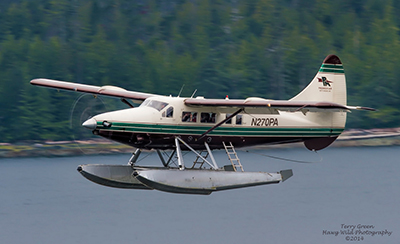
Otter N959PA – The DHC-3 Otter floatplane operated by Taquan Air departed from Rudyerd Fjord, approximately 40 miles northeast of Ketchikan, with ten passengers on a scenic flight. The flight was part of a "boat fly" operation where the passengers inbound to the fjord are deplaned at a large floating dock, and outbound passengers board and continue the air tour, ultimately landing at the company’s Ketchikan Harbor Seaplane base. The Otter departed the fjord at approximately 1203, flying toward the southeast with the intention of flying over Manzoni Falls before turning southwest to return to Ketchikan.
Beaver N952DB – The DHC-2 Beaver floatplane operated by Mountain Air Services with four passengers and one pilot onboard also departed Rudyerd Fjord for a sightseeing flight that would include a viewing of Manzoni Falls before returning to Ketchikan.
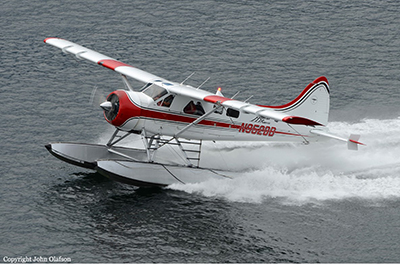
Airplane Details
Otter N959PA – The DHC-3 Otter is a single-engine, propeller-driven, high-wing, short-takeoff-and-landing (STOL) airplane with a cruciform tail. This Otter was powered by a Pratt & Whitney PT6A turboprop engine, equipped with Edo 7490 floats, and configured for one pilot and ten passenger seats. The Otter was manufactured in 1956 and had accumulated more than 30,000 hours on the airframe at the time of the accident. Taquan Air began operating the airplane in 2016.
Beaver N952DB – The DHC-2 Beaver is a single-engine, propeller-driven, high-wing STOL airplane. This Beaver was powered by a Pratt & Whitney R-985 radial engine and equipped with Edo 58-4580 floats. The airplane was configured with one pilot and six passenger seats. The airplane was built in 1951 and had accumulated approximately 16,500 airframe hours at the time of the accident. Mountain Air Services acquired the Beaver in 2012.
Collision Avoidance Details and See and Avoid Best Practices
Per 14 CFR 91.113 Right of Way rules during the VFR flight, pilots are required to "maintain vigilance" to "see and avoid" other airplanes. There are multiple challenges, including physiological and environmental conditions; airplane structure and blind spots; and operational distractions that leave “even the most diligent pilot vulnerable to the threat of a midair collision with unseen aircraft,” according to the NTSB.
This video produced by the US Helicopter Safety Team (USHST) discusses many of the best practices for all aircraft, not just helicopters.
According to the U.S. Air Force, nearly all midair collisions occur within five miles of an airport during the day and in VFR conditions. Most of these accidents involve relatively slow closing speeds, such as an aircraft being overtaken or aircraft converging on final approach.
When pilots do see a traffic conflict, they are required to alter their course to the right for head-on scenarios; and when overtaking another aircraft from behind, they are required to alter their course to the right and to pass "well clear."
The key to an avoidance maneuver is to see the traffic. The FAA provides information and best practices to aid pilots in identifying traffic threats, including the following:
Information:
- A distant aircraft on a collision course appears small and motionless. It remains this way for a relatively long time, then suddenly "blooms" into a mass filling airplane windows.
- Varicolored terrain or areas heavily dotted with buildings can cause traffic to blend into the background until it is quite close.
Best Practices:
- During the walk-around inspection, pilots should verify the windshield is clean from dirt and debris that may hide airborne traffic. All windows should also be clear of obstructions, such as solid sun visors and curtains.
- When a pilot’s vision is partially blocked by a windshield post or other object, they should move their head position, not just their eyes, when scanning for traffic.
- Flying above the haze layer on a hazy day helps pilots identify oncoming traffic.
- Strobes and rotating beacons make an airplane more visible to other aircraft.
- Using landing lights in the traffic pattern, whether day and night, increases the chances of being seen.
- When approaching an airport, whether planning for a landing or not, pilots should make a radio call when 15 miles from a towered airport and 10 miles from a non-towered airport to announce position, altitude, and intentions.
- When participating in VFR flight with ATC advisories (flight following), pilots should never assume that ATC provides alerts to all traffic in the vicinity. ATC traffic services for VFR aircraft are provided on a workload-permitting basis.
- Although passengers frequently are not pilots, they can assist in the pilot’s see-and-avoid responsibility. Pilots should train their passengers how to be observers of traffic. (Credit: Tom Turner: Flying Lessons; June 20, 2024)
- Show passengers what a typical general aviation airplane looks like at a distance of concern (1 mile or less), for example in the traffic pattern.
- Advise passengers about the "o'clock" system for identifying an airplane's position relative to one’s own position, using phrases such as, "I see traffic, 3 o'clock, level."
ADS-B Systems
Technology in the cockpit that displays or alerts pilots to conflicts with nearby aircraft can aid in the see-and-avoid process. ADS-B is one such system that is readily available in the United States to the general aviation (GA) community at relatively low cost. As of January 1, 2020, ADS-B Out is required for flight in certain airspace (see graphic) and, to date, a large percentage of the GA fleet is equipped. ADS-B Out sends an aircraft's position, velocity, and other data to other aircraft in the vicinity and to the FAA's ADS-B ground network. When coupled with onboard ADS-B In and displayed on a traffic application, which are relatively inexpensive to acquire, pilots have a powerful tool to help compensate for the inherent limitations of see-and-avoid, reducing midair collision risk.
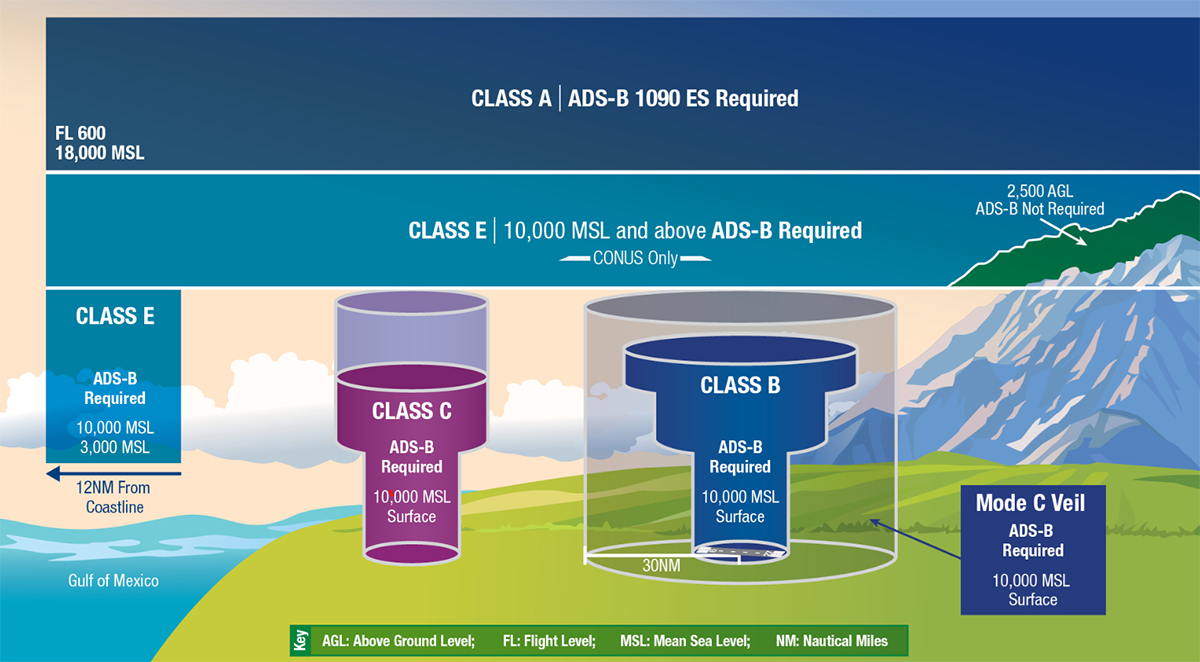
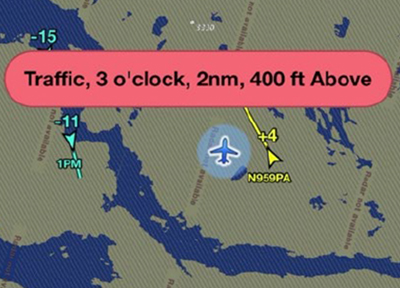
ADS-B Out systems for GA aircraft generally use the GPS global navigation satellite system augmented with the FAA’s Wide Area Augmentation System (WAAS) that enhances accuracy and integrity to generate precise location information for air traffic control surveillance and for aircraft-to-aircraft traffic awareness.
When equipped with ADS-B Out, an aircraft broadcasts its satellite-based position, altitude, velocity, and other data at a rate of once per second to aircraft in the vicinity and to the FAA through a nationwide network of ADS-B ground stations. Nearby aircraft equipped with ADS-B In, an installed or portable display, and a traffic application receive traffic information and generally provide visual and aural alerts.
The FAA fuses ADS-B data with surveillance data from legacy radar systems (which includes aircraft using Mode C transponders) and rebroadcasts the data to aircraft in the vicinity of the ground stations, providing pilots with a comprehensive picture of transponder- and ADS-B-equipped aircraft in the area. Note that gliders, ultralights, and other aircraft that are not equipped with ADS-B or legacy Mode C transponders will not show up as ADS-B In traffic.
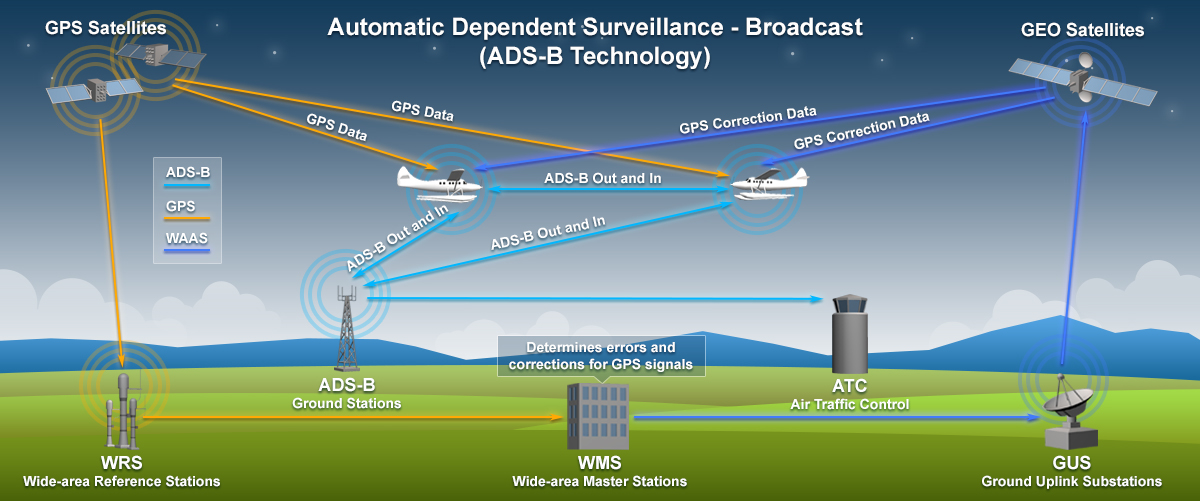
When an aircraft is equipped with suitable and correctly operating ADS-B Out and In with an installed or portable display, pilots see nearby traffic as blue arrowhead symbols. Nearby aircraft in "alert status" are displayed as yellow or red targets, depending on proximity. Flight navigation software applications generally provide a popup message on the screen and aurally when an ADS-B target approaches to within certain horizontal and vertical thresholds of an aircraft, also referred to as ownship. The alert notes the target's clock position, distance, and relative altitude.
Video of enhancing see and avoid with ADS-B technology. Source: FAA/John Croft
Prior to takeoff, pilots should verify that the ADS-B system is configured and operating per applicable checklists. Post-flight, pilots should frequently (or at least annually) check the performance status of their ADS-B system by requesting a no-cost Public ADS-B Performance Report (PAPR). Elements that do not meet performance requirements are highlighted in red in the report.
Missing Elements:
| Category | NACp | NACv | Vel | Flight Id | Mode 3A | Emit Cat | Mode 3A | Galt |
|---|---|---|---|---|---|---|---|---|
| % Fail | 0.00% | 0.00% | 0.00% | 0.09% | 0.00% | 0.00% | 20.93% | 0.00% |
| Max dT | 0:00:00 | 0:00:00 | 0:00:00 | 0:00:05 | 0:00:00 | 0:00:00 | 0:03:18 | 0:00:00 |
| % MCF | 0 | 0 | 0 | 5 | 0 | 0 | 267 | 0 |
If pilots experience issues with ADS-B while flying, for example, if receiving false traffic targets, they should report the anomalies to the FAA at this link: ADS-B Services: Report an Issue.
Pilots should also be aware that while ADS-B provides traffic alerts, it does not provide resolution advisories (RA) to avoid a collision as do certain Traffic Alert and Collision Avoidance Systems (TCAS) required by the FAA for commercial transport airplanes. There are two types of TCAS, I and II. TCAS I, which provides traffic advisories (TAs) only, is required on all turbine-powered, passenger-carrying airplanes with ten to 30 seats. TCAS II, which is required on all commercial airplanes with more than 30 seats or a maximum takeoff weight of more than 33,000 lbs., issues TAs and RAs, which provide pilots with vertical guidance to avoid a collision.
For a detailed discussion on TCAS, see the Overview section of the lessons learned module from the July 1, 2002 midair collision between a Bashkirian Airlines TU154M and a DHL Boeing 757-200 over Überlingen, Germany.
ADS-B Equipage in this Accident
Although both airplanes involved in the Ketchikan midair collision were equipped with the ADS-B avionics and displays capable of generating visual and aural alerts, there were various issues that prevented both pilots from receiving alerts, as shown in the table.
| ADS-B | Control Head (Off/On) | Display | Traffic | Visual Alert | Aural Alert | |
|---|---|---|---|---|---|---|
| Otter | Rangr 978 | GSL 71 (Off) | Chelton EFIS | Yes | Not provided | Not provided |
| Beaver | Rangr 978 | TC-978 (On) | iPad/ForeFlight | Potentially * | Not possible ** | Not possible ** |
| * This depends on which ForeFlight display option was chosen by the pilot for the "Hide Distant Traffic – ON/OFF" setting. The default setting is "OFF", which if chosen by the pilot would have resulted in a visual display of the Otter traffic, but without an associated relative altitude. If the pilot had selected "On", the Otter traffic would not be displayed. Investigators could not determine what the pilot selected. ** The software in the Beaver pilot's ForeFlight application would not generate a visual or aural alert for the Otter traffic because the Otter's GSL 71 was turned off and was not transmitting pressure altitude. Because of this, The software has since been updated to generate an alert regardless of the pilot’s selection of the "Hide Distant Traffic – ON/OFF" setting. Based on the data collected by the NTSB, neither aircraft was equipped with a mode C transponder. Had the Otter been equipped with an operating transponder, pressure altitude would have been available to secondary radar and a TIS-B with the pressure altitude would have been generated to represent the Otter, and ForeFlight alerting would have occurred. |
||||||
Otter N959PA – The DHC-3 Otter was equipped with ADS-B Out and In, using an installed transceiver and a panel-mounted display to aid the pilot in traffic awareness. A selector knob on a separate control panel was required to be in the ON position for the airplane’s barometric altitude and transponder code to be broadcast to the ADS-B ground network and to other airplanes. The NTSB, in its post-crash investigation, found that the selector knob was in the OFF position. The avionics installation in this airplane did not provide, nor was it required to provide, a traffic alerting option for the pilot.
Beaver N952DB – The DHC-2 Beaver was equipped with ADS-B Out and In using an installed transceiver and an onboard wireless network that allowed the pilot to display ADS-B traffic and other information on a portable iPad running the ForeFlight navigation application. In post-crash simulations, NTSB investigators could not determine if the Otter had been displayed as traffic on the Beaver pilot’s iPad. They determined that given the lack of altitude information being broadcast by the Otter, the Beaver pilot would not have received a visual or aural alert from ForeFlight.
The Collision
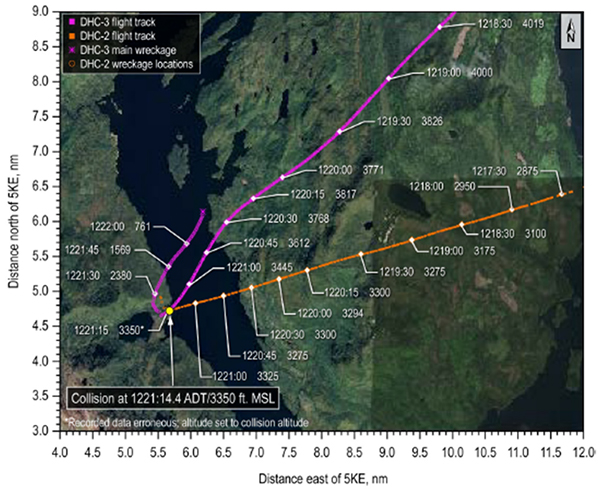
The Otter pilot, during interviews with the NTSB and FAA, recalled seeing "two groups of blue triangles" representing airborne traffic on the traffic display in the minutes leading up to the collision, but those were to the left of course and the pilot did not consider them to be a threat based on location. The pilot also discussed the various tour operator tasks which competed with see-and-avoid responsibilities.
Distractions noted by the pilot included operating the VHF and company-specific radios, operating an iPhone that provides music to the passengers, checking the surface of lakes to determine wind direction for planning a landing if the engine were to fail, as well as pointing out interesting sights to the passengers. Regarding the collision, the pilot remembered seeing a flash out of his peripheral vision and seeing "white and red" before feeling a "tremendous collision." He did not remember seeing the Beaver show up as traffic on the display, and as the NTSB later determined, the avionics did not provide a visual or aural notification.
In the NTSB's cockpit visibility study, investigators determined that in the three minutes prior to the collision, the Beaver pilot would not have been able to see the Otter, which was above and behind his airplane. The Otter was obscured by the cockpit structure, the right wing, and the passenger in the right front seat. The obscuration, as well as a full timeline of the crash, is available in this NTSB video.
Accident sequence. Source: NTSB
The Otter pilot could not see the Beaver due to its relative stationary position and the layout of the Otter cockpit. Aircraft on a collision course appear to be motionless to the pilot, except for the aircraft gradually becoming larger in the windscreen and eventually blooming just before the collision. In this case, the Beaver was hidden from the Otter pilot's line of sight by the left window post. It was not until about one second before the crash that the pilot would have begun to see the Beaver emerging ahead of the left window post.

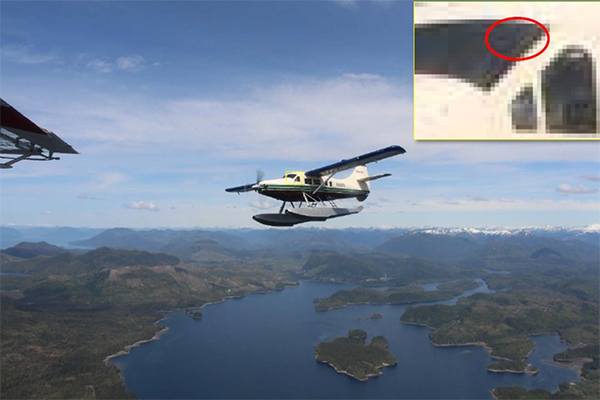
The NTSB determined that had the Otter pilot's head been positioned three inches farther forward, the Beaver may have been visible for about 51 seconds prior to the accident. Researchers note that it takes about 12 seconds for an unaware pilot to spot traffic with a closure rate of 120 kts, identify it as a threat, and initiate an evasive maneuver. Pilots who have ADS-B In with visual and aural traffic alerts can expect to visually acquire the conflicting traffic, in this example, about eight seconds earlier.
The airplanes ultimately collided due to the inability of both pilots to see and avoid the other airplane, combined with the lack of visual and aural alerting from the installed ADS-B systems.
Overview of GA Midair Collisions
According to the GA Fatal Aircraft Accident Pareto published by the General Aviation Joint Safety Committee (GAJSC) and based on NTSB data, midair collisions (MAC) were ninth in the top causes of fatal GA accidents between 2008 and 2021.
NTSB data shows that from 2012 through 2021, there were an average of seven midair collisions per year, about half of which resulted in fatalities. Most accidents occurred in the en route phase of flight, followed by the maneuvering and approach phases.

View Larger
ADS-B as a Preventative Measure
During the development of ADS-B, the FAA convened a group of subject matter experts who predicted that the technology could reduce GA midair collisions by more than 70% (Surveillance and Broadcast Services Benefits Basis of Estimate August 2007). Given the newness of the 2020 ADS-B mandate and the 12-18 months required to complete NSTB final reports, there is not yet enough data to determine the early effects of ADS-B on the midair collision rate.
Although not required by the ADS-B Out rule, ADS-B In is relatively inexpensive and offers significant benefits, including traffic information, Nexrad weather, and other safety-related information transmitted from the FAA's ADS-B ground network. In the avionics portion of the 2022 General Aviation and Part 135 Activity Surveys, the FAA estimated that roughly 75% of the GA fleet had equipped with ADS-B Out and ADS-B In.
Once equipped, pilots generally download software applications, for example from ForeFlight or Garmin or a host of other providers, that display nearby traffic and provide cautions and warnings when traffic approaches within certain bounds. Unlike the TCAS avionics installed on Part 121 commercial airplanes however, the software does not provide RA guidance that could prevent the collision. In practice, pilots with ADS-B In often make heading and/or altitude changes well in advance of a threat and make their own necessary tactical maneuvers using see-and-avoid rules once they are aware of the traffic.
Given the advantages that ADS-B provides for pilots flying in any airspace, the GA community is interested in developing lower-cost ADS-B systems that could be used outside of airspace where certified ADS-B systems are required. In the FAA five-year reauthorization bill passed in 2024, the U.S. Congress required the FAA to study such systems.
ADS-B Limitations and Best Practices
This accident, like many similar collisions, highlights the limitations of see and avoid, but also the limitations of technology. Even when aircraft are equipped with ADS-B, there is no guarantee that traffic will be displayed and/or alerts provided if the operators and pilots do not fully understand the capabilities of the installed avionics, set the configuration per system requirements, or follow checklist procedures to assure functionality.
Best practices for pilots using ADS-B:
- Become familiar with the features of ADS-B Out and In equipment and how to use it properly
- Understand not all aircraft will be equipped with ADS-B Out as the technology is only required in certain airspace
- Consider that other aircraft may be equipped with ADS-B, but the avionics may not be operating correctly
- Incorporate the traffic display in a normal cockpit and external traffic scan to provide awareness of nearby aircraft
- Use ADS-B In when near airports to provide advance indication of arriving aircraft and aircraft in the traffic pattern
Conclusion
Once pilots become proficient in using ADS-B, they rapidly become believers in the technology and many tell stories about how it has saved them from what would have been a close call or collision. Once equipped, many pilots consider ADS-B to be as essential as safety belts.
It is important to note the limitations on ADS-B, given the potential for pilots to become overly dependent on the technology at the expense of see-and-avoid vigilance. Per the Aeronautical Information Manual, an ADS-B cockpit display of traffic "does not relieve the pilot's responsibility to 'see and avoid' other aircraft."
To reduce the risk of a midair collision, pilots should integrate technologies that display traffic with time-tested best practices for see and avoid.
The NTSB determined that the probable cause of this accident was the "inherent limitations of the see-and-avoid concept" that created a scenario where the pilots of each aircraft did not see each other before the collision. The NTSB also determined a probable cause was the absence of visual and aural alerts about the impending collision while operating in a geographical region with a high concentration of air tour activity.
The NTSB's report included 12 findings. Following are select findings related to and the availability of ADS-B equipage on a voluntary basis:
- Because of the high concentration of traffic in popular air tour areas, the risk of collision is higher than in the general National Airspace System, and technology that supplements pilots' traffic scans by providing aural and visual alerts can mitigate this risk.
- Aural and visual alerts that draw the pilots' attention to conflicting traffic presented on the cockpit display of traffic information can greatly increase the pilots' awareness of potentially conflicting traffic and help avoid a collision.
- Although existing ADS-B traffic alerting applications can help draw pilots' attention to conflicting traffic, these applications are currently not required.
NTSB accident report: AAR-21/04
The NTSB issued ten new recommendations (six to the FAA; one to ForeFlight; one to Taquan Air; one to aviation industry groups; one to the National Association of Flight Instructors and the Society of Aviation Flight Educators) and reiterated one previously issued recommendation to the FAA. Included in the recommendations were:
- FAA to require Part 91 and Part 135 air tour companies operating in identified high-traffic areas to equip with ADS-B Out and ADS-B In systems that include visual and aural alerts during all flight operations, and all non-tour aircraft operating in this same high-traffic airspace be equipped, at a minimum, with ADS-B Out
- FAA to update the Aeronautical Information Manual and Pilot’s Handbook of Aeronautical Knowledge to include limitations inherent in visual scanning for traffic and benefits of using ADS-B traffic to supplement visual scanning
- Aviation groups (AOPA, EAA, NBAA etc.) and flight instructor organizations to inform members of the importance of including the traffic display when scanning for traffic in both initial and recurrent pilot training
Full list of NTSB recommendations
This accident involves pilot responsibilities for see and avoid as well as for assuring that onboard equipment operates as intended.
See and Avoid
14 CFR Part 91.113 Right of Way Rules: When weather conditions permit, regardless of whether an operation is conducted under instrument flight rules or visual flight rules, vigilance shall be maintained by each person operating an aircraft to see and avoid other aircraft. When required to give another aircraft the right-of-way, the pilot shall give way to that aircraft and may not pass over, under, or ahead of it unless well clear. Note that per 14 CFR Part 135.61, pilots must follow Part 91 rules in addition to Part 135 rules.
Advisory Circular 90-48E Pilots' Role in Collision Avoidance: This AC is written to alert pilots of human contributors to midair collisions and near midair collisions (NMAC) and recommends improvements to pilot education, operating practices, procedures, and scanning techniques to reduce midair conflicts.
Aeronautical Information Manual Chapter 4 Sections 1-4 and Chapter 5 Sections 2-4.
These sections contain information on services available to pilots, including information on VFR advisory services, radar traffic information services for VFR pilots, recommended traffic advisory practices at non-towered airports, and radio communication techniques. Also included is information on the use of Visual Clearing Procedures and Scanning Techniques. "Pilots must be aware of the limitations inherent in the visual scanning process..."
Aeronautical Information Manual Chapter 4 Section 4-3-23: Operation Lights On. The FAA has a voluntary pilot safety program, Operation Lights On, to enhance the see-and-avoid concept. Pilots are encouraged to turn on their landing lights during takeoff (i.e., either after takeoff clearance has been received or when beginning takeoff roll). Pilots are further encouraged to turn on their landing lights when operating below 10,000 feet, day or night, especially when operating within ten miles of any airport, or in conditions of reduced visibility and in areas where flocks of birds may be expected (i.e., coastal areas, lake areas, around refuse dumps, etc.). Although turning on aircraft lights does enhance the see-and-avoid concept, pilots should not become complacent about keeping a sharp lookout for other aircraft. Not all aircraft are equipped with lights and some pilots may not have their lights turned on. Aircraft manufacturer's recommendations for operation of landing lights and electrical systems should be observed.
Aeronautical Information Manual Chapter 8 Section 8-1-6: Vision in Flight – Scanning for other aircraft. "Scanning the sky for other aircraft is a key factor in collision avoidance. It should be used continuously by the pilot and copilot (or right seat passenger) to cover all areas of the sky visible from the cockpit..."
Pilot and Flightcrew Awareness of Class B Airspace Boundaries – SAFO 17001.
This SAFO serves to alert all pilots and flight crew operating near the boundaries of Class B airspace to the risk of excursions out of and incursions into Class B airspace. The alert emphasizes the importance of a pilot’s and flight crew's role in maintaining proper aircraft separation in these circumstances.
ADS-B
14 CFR Part 91.225 (f) Except as prohibited in paragraph (i)(2) of this section, each person operating an aircraft equipped with ADS-B Out must operate this equipment in the transmit mode at all times.
14 CFR Part 91.227 Defines performance requirements for ADS-B Out.
14 CFR Part 23.2530 External and Cockpit Lighting and 14 CFR Part 25.1401 Anti-Collision Light System These rules specify the types and operational specifications of anti-collision lighting systems that must be installed on normal category (Part 23) and transport category (Part 25) aircraft.
Aeronautical Information Manual Section 4-4-15: Use of Visual Clearing Procedures and Scanning Techniques. "ADS-B In is an effective system to help pilots see and avoid other aircraft. If your aircraft is equipped with ADS-B In, it is important to understand its features and how to use it properly."
NTSB Safety Alert – Do not depend on vision alone to prevent a midair collision. "Technologies in the cockpit that display or alert of traffic conflicts, such as traffic advisory systems and automatic dependent surveillance-broadcast (ADS-B), can help pilots become aware of and maintain separation from nearby aircraft."
Throughout aviation history, high-profile accidents have driven government and industry to deploy safety technologies that have in many cases all but eliminated those types of accidents. This has been true for midair collisions in commercial aviation through the incremental deployment over time of procedural and technological improvements. This animation provides a timeline of the high-profile accidents that led the way to a drastic decrease in the number of midair collisions in the airline sector. The FAA's expectation is that ADS-B can provide similar improvements for the GA community.
The inherent limitations of the see-and-avoid concept – Both pilots’ ability to visually acquire the other airplane was compromised by their restricted field of view from the cockpit (based on passenger seating, airplane structure, etc.).
The risk of midair collisions in high-traffic areas – Pilots and operators can reduce accident risk by supplementing visual scans with ADS-B Out- and In-supported traffic advisory systems with aural and visual alerts, particularly when operating in high-density and/or task-saturated environments.
The lack of traffic alerting on both airplanes – Although both airplanes were equipped with ADS-B Out, ADS-B In, and cockpit displays, configuration settings and software notification capabilities resulted in neither pilot being alerted to the impending collision. Had these issues not existed, aural traffic alerts in each airplane may have occurred early enough for the pilots to have prevented the collision.
Pilots and operators who have equipped their aircraft with ADS-B Out and In receive traffic alerts that minimize the risk of midair collisions.
- In this accident, the DHC-2 Beaver did not receive a traffic alert regarding the DHC-3 Otter because the Otter’s avionics were not properly configured. The Otter pilot could not have received a traffic alert regarding the Beaver as the Otter’s avionics did not have the capability to issue a traffic alert.
The potential for midair collisions can be reduced by pilots scanning the horizon.
- In this accident, see-and-avoid practices alone were not sufficient to alleviate the collision risk. Visual constraints, including the front seat passenger and airplane structure, prevented the DHC-2 Beaver pilot from seeing the DHC-3 Otter. For the Otter pilot, structural components in the cockpit prevented the pilot from seeing the Beaver, which, given the collision course, would have been a relatively fixed position in the windscreen.
- Pilots operating in high-density or air tour operations may have duties associated with passenger comfort and tour guide entertainment that can potentially compete with higher priority see-and-avoid responsibilities.
Incomplete Capstone 2 Avionics Upgrade
As part of the FAA’s Capstone 2 program in Alaska, the agency updated the ADS-B avionics in all participating aircraft, including the DHC-3 Otter. While the Capstone 1 avionics included a traffic alerting function, the new transceivers for Capstone 2 did not. The NTSB concluded that the FAA had not mitigated the increased risk due to the reduced functionality, and as such, included the incomplete upgrade as a contributing factor in the accident.
Eurocopter AS350BA, Liberty Helicopters, N401LH; Piper PA-32R-300 N71MC, Hoboken, New Jersey, August 08, 2009
A Piper PA-32R-300 collided with a Eurocopter AS350BA air tour helicopter over the Hudson River near Hoboken, New Jersey. Both aircraft were equipped with transponder-based traffic information service (TIS) avionics, which could generate a visual display of traffic. The NTSB determined the probable cause of the accident to be the inherent limitations of the see-and-avoid concept, which made it difficult for the airplane pilot to see the helicopter until the final seconds before the collision. Contributing to the accident were both pilots’ ineffective use of the TIS to maintain awareness of nearby aircraft.
NTSB accident report: ERA09MA447
Eurocopter EC-135-P2, PHI Inc, N312PH; Cessna 172H, N2876L, Weyers Cave, Virginia, December 31, 2010
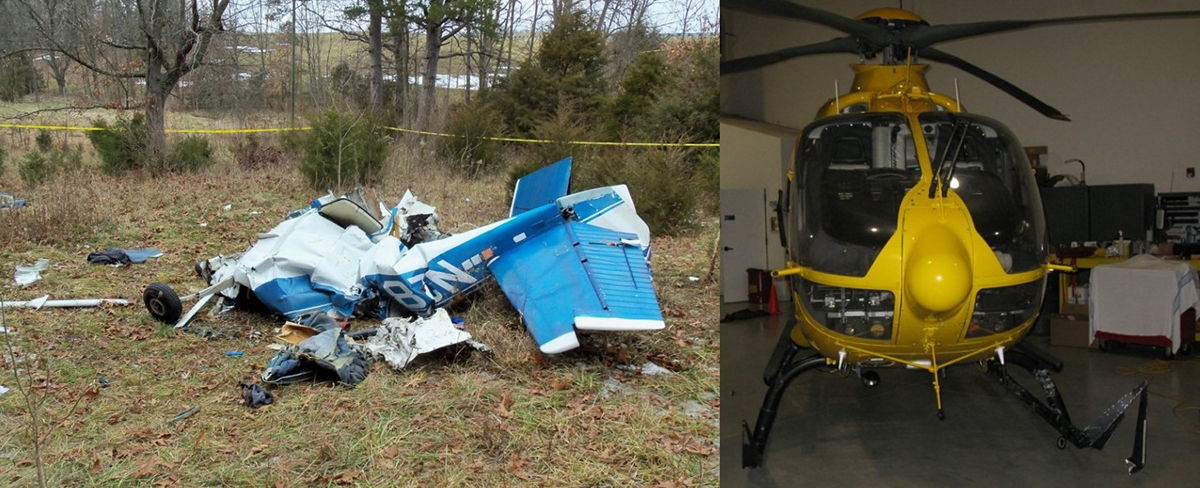
A Eurocopter EC-135-P2 helicopter collided with a Cessna 172H as the two aircraft were approaching the Shenandoah Valley Regional Airport. The Eurocopter was equipped with a traffic collision avoidance device (TCAD) which receives input from the Mode C transponders of nearby aircraft. The helicopter crew recalled seeing traffic information for other aircraft in the pattern, but not for the accident C172. The NTSB determined the probable cause the accident to be the inherent limitations of the see-and-avoid concept which made it difficult for the helicopter pilot to see the aircraft before the collision (the helicopter descended into the C172). Because of the high-wing configuration of the C172 and its relative position and altitude with respect to the helicopter, the C172 pilot would not have been able to see the helicopter before the collision.
NTSB accident report: ERA11FA101
Updated ADS-B Technical Standard Order (TSO)
Since the accident, there have been several updates to the ADS-B TSO 195c including adding a requirement that ADS-B In have ATAS (ADS-B Traffic Advisory System).
- ATAS includes audio alerting
- If target traffic lacks barometric altitude information, then the TSO C195c avionics must use the traffic geo-referenced altitude versus the ownship-referenced geo altitude data for traffic alerting
Updated Ketchikan Operators Agreement
As a result of this accident, a group of 14 Ketchikan commercial operators updated a Letter of Agreement (LOA). Originally created in January 2009, the LOA was confirmation of voluntary compliance with the routes, procedures, and safe practices established for operating in the Ketchikan and Misty Fjords National Monument Wilderness area. Taquan Air was one of the operators that signed the LOA. Additionally, Taquan Air had each of its pilots sign a document stating they read and fully understood the LOA and agreed to comply with it. The update specifically addressed certain best practices to follow, including:
- Use of anti-collision lights, "pulse" lights, or aircraft landing lights at all times when aircraft are being flown
- All company aircraft equipping with and using ADS-B Out and In at all times
- All pilots announcing position reports at all reporting points identified in the agreement
View the full list of best practices from the LOA here.
Update to midair collision avoidance best practices in the Aeronautical Information Manual (AIM) and the Pilot's Handbook of Aeronautical Knowledge (PHAK)
The FAA in November 2022 published revised text for the AIM, Section 4-4-15, Use of Visual Clearing Procedures and Scanning Techniques, on the benefits and best practices of using cockpit displays of traffic information to supplement visual scans. The FAA is incorporating a similar update to the PHAK. This action was in direct response to the NTSB recommendation that the FAA update the Aeronautical Information Manual and the Pilot’s Handbook of Aeronautical Knowledge to include the limitations inherent in visual scans for traffic and the benefits and best practices of using cockpit displays of traffic information to supplement visual scans to help overcome these limitations.
Update to traffic alerting algorithms in ForeFlight
ForeFlight has modified the software in its traffic application so that aircraft not reporting geometric altitude or pressure altitude are displayed as a target at the same altitude as the ownship for the purposes of alerting. In discussions between NTSB and ForeFlight, the NTSB recommended and ForeFlight agreed to update its traffic alerting algorithms so that traffic targets for which there is no altitude information are assumed to be at the same altitude as the ownship.
New Special Federal Aviation Regulation (SFAR)
The FAA is moving forward with an SFAR, anticipated in 2028, for the Misty Fjords area. The SFAR will include:
- A definition of the boundaries of the Misty Fjords area for the purpose of the SFAR
- A requirement for increased VFR weather minimums
- A requirement for ADS-B In and Out
- A requirement that all air tour operators in the Misty Fjords area must be Part 135
- Operators must provide floatation devices and instructions for use
- Operators must provide pre-flight passenger briefing on water ditching procedures
Small Airplane Life Cycle
- Operational
Accident Threats
- Midair Collisions/Incursion
Operations
- Business/Commercial
Accident Common Themes
- Human Error
- Flawed Assumptions
Human Error
In this accident, both pilots were flying in daytime, unrestricted visibility, VFR conditions, but there were visual and technical issues for both pilots that affected the identification of midair collision threats. The Otter pilot did not ensure that the aircraft’s ADS-B system was properly configured and did not account for cockpit structure blockages in the traffic scan.
Pilots must move their head and body position to see around obstacles and structures in the cockpit to scan for traffic. Based on a passenger photo that the NTSB analyzed, the Otter pilot's view of the Beaver was blocked by airplane structure and would not have been visible if the Otter pilot was not actively looking around the structure.
Pilots must ensure all elements of the ADS-B system are functional. The Otter pilot had not confirmed that the GSL-71 system was turned ON. In the OFF position, the ADS-B did not broadcast altitude information that otherwise could have provided the Beaver pilot with a visual and aural alert of the impending collision.
Flawed Assumptions
In this accident, both airplanes were equipped with ADS-B Out and In technology and therefore the pilots may have had the reasonable expectation that they would have seen traffic on their displays, and for the Beaver pilot, that the avionics would provide traffic alerts. However, for a variety of reasons discussed in this module, neither pilot received critical traffic alerts prior to the midair collision.
The Otter pilot may have assumed that the checklist would have covered all the necessary steps for assuring the ADS-B avionics were properly configured. The NTSB determined that the Otter checklist did not have an item related to making sure the GSL-71 system was powered ON.
The pilots may have assumed that the best practices in waypoint reporting and preferred routing information called out in the May 2018 Ketchikan Commercial Operators Letter of Agreement would have provided heightened awareness and adequate separation. This agreement was updated after the collision to include additional preventative measures. Revised Letter of Agreement.
Both pilots may have assumed that the radio communications and altitude best practices (for flights in opposing directions) shared among tour providers would create procedural separation.
In this collision, both airplanes were headed in roughly the same direction therefore the altitude separation criteria would not have helped. The NTSB did not comment on whether the operators were talking on the recommended air-to-air frequency of 122.75 MHz.
Piper PA-28-181 (Archer), Robinson R22, Chandler, Arizona, October 1, 2021
The low-wing Piper Archer and an R22 helicopter, both with flight instructors on board, were conducting takeoffs and landings at the tower-controlled airport in daytime VFR conditions. The R22 was flying a right-handed pattern to a taxiway that paralleled the runway to which the Piper was flying right-handed patterns, outside and above the Robinson. The collision occurred when the Piper instructor performed an engine-out maneuver to the runway and descended into the R22. The NTSB determined the probable cause of the accident was the failure of the pilots in the Piper to see and avoid the helicopter while maneuvering in the traffic pattern, which resulted in a midair collision. Both aircraft were equipped with ADS-B. The Piper aircraft had a portable traffic display, but the flight instructor did not recall receiving any traffic advisories related to the R22.
NTSB accident report: WPR22FA001
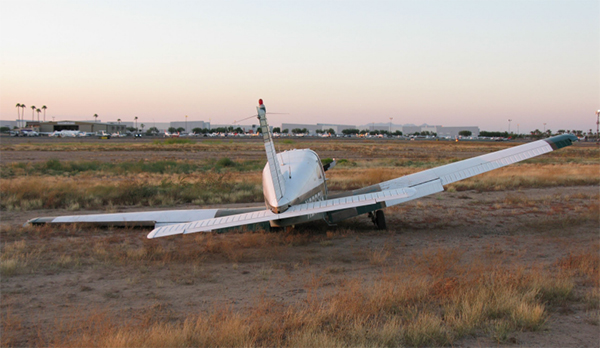
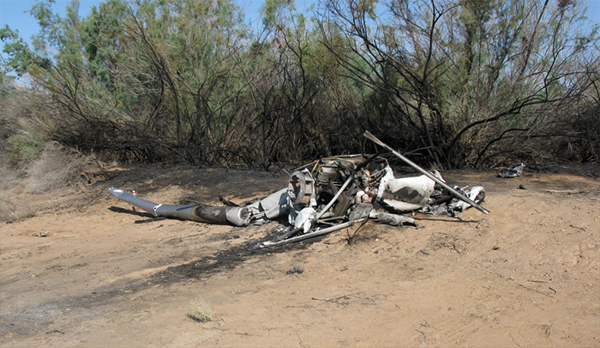
Trans World Airlines Lockheed L-1049 Super Constellation, United Airlines Douglas DC-7, Grand Canyon, Arizona, June 30, 1956
On June 30, 1956, TWA Flight 2, a Lockheed Super Constellation, collided with United Air Lines Flight 718, a Douglas DC-7, over the Grand Canyon. Both airplanes fell into the canyon. There were no survivors among the 128 persons aboard the flights. This accident involved two of the largest commercial airplanes in service and was the deadliest aviation disaster in history at that time. It was a catalyst for changes to the air traffic control system and led to the creation of the FAA.
Library module: Lockheed L-1049 Super Constellation and Douglas DC-7
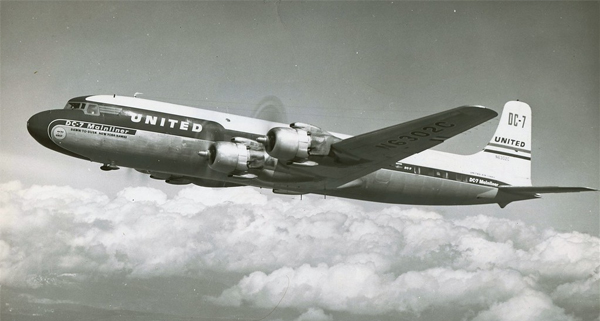
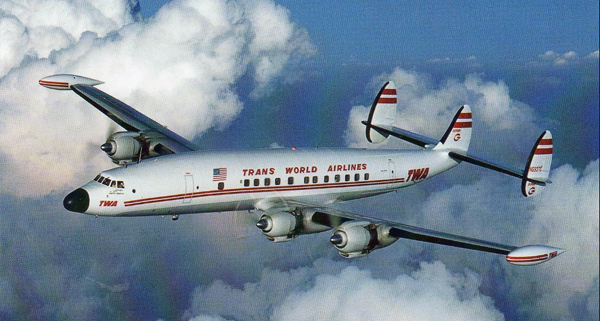
Pacific Southwest Airlines Boeing 727-214, Cessna 172, San Diego, California, September 25, 1978
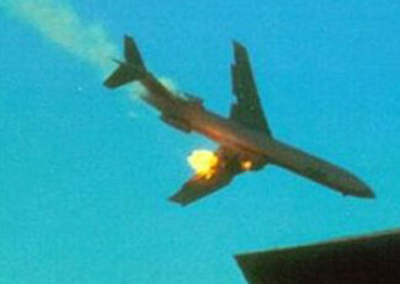
On September 25, 1978, Pacific Southwest Airlines, Inc., Flight 182, a Boeing 727-214, and a Gibbs Flite Center, Inc., Cessna 172, collided in midair about three nautical miles northeast of Lindbergh Field, San Diego, California. Both airplanes crashed in a residential area. All 137 people on both airplanes, along with seven persons on the ground, were fatally injured. Nine persons on the ground were injured. Twenty-two dwellings were damaged or destroyed. The weather was clear, and the visibility was ten miles.
The NTSB determined that the probable cause of the accident was the failure of Flight 182’s pilots to comply with the provisions of a maintain-visual-separation clearance, including the requirement to inform the controller when they no longer had the other airplane in sight.
Library module: Boeing 727-214 and Cessna 172
Aeronaves de Mexico DC-9-32, Piper PA28-181, Cerritos, California, August 31, 1986
On August 31, 1986, about 1152 Pacific daylight time, Aeronaves de Mexico, S.A. Flight 498, a DC-9-32 with Mexican Registration XA-JED, and a Piper PA-28-181, N4891F, collided over Cerritos, California. Flight 498, a regularly scheduled passenger flight, was on an IFR flight plan from Tijuana, Mexico to Los Angeles International Airport, California, and was under radar control by the Los Angeles terminal radar control facility. The Piper airplane was proceeding from Torrance, California toward Big Bear, California, under VFR, and was not in radio contact with any air traffic control facility when the accident occurred.
The NTSB determined that the probable cause of the accident was the limitations of the air traffic control system to provide collision protection through air traffic control procedures and automated redundancy. Factors contributing to the accident were: (1) the inadvertent and unauthorized entry of the PA-28 into the Los Angeles Terminal Control Area, and (2) the limitations of the see-and-avoid concept to ensure traffic separation under the conditions of the conflict.
Library module: McDonnell-Douglas DC-9-32 and Piper PA28-181
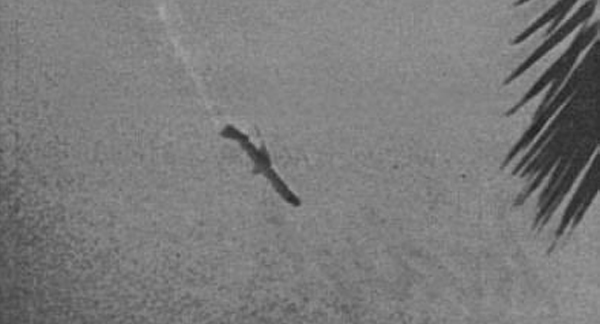
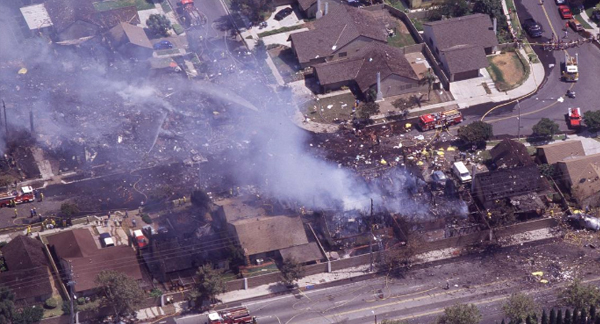
Bashkirian Airlines Tupolev TU154M, DHL Boeing 757-200, Überlingen, Germany, July 1, 2002
On July 1, 2002 at 21:35:32 (UTC), a Tupolev TU154M passenger airplane flying as Bashkirian Airlines Flight 2937 from Moscow, Russia to Barcelona, Spain and a Boeing 757-23APF cargo airplane operating as DHL International Flight 611 from Bergamo, Italy to Brussels, Belgium experienced a mid-air collision over the town of Überlingen, Germany near Lake Constance. Both airplanes were destroyed. All aboard both airplanes were killed; 60 passengers and nine crew members on the passenger airplane, and the pilot and copilot on the cargo airplane. Both aircraft were equipped with TCAS II.
In this accident, investigators concluded that one carrier involved had trained crews that ATC instructions retained priority, and not to maneuver in contradiction to ATC instructions. Conversely, the other carrier involved in the accident had trained crews that TCAS instructions held priority, and to maneuver in accordance with a TCAS resolution advisory (RA), independent of any other ATC instructions. Investigators concluded that this conflict was a major contributor in this accident, as one of the airplanes involved followed ATC instructions, counter to a TCAS RA, and the other followed the RA, resulting in both aircraft remaining on a collision course.
Library module: Tupolev TU154M and Boeing 757-200
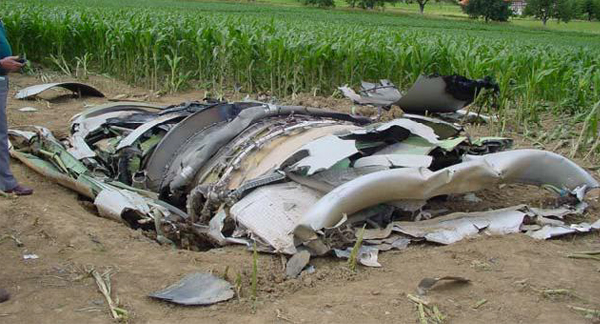
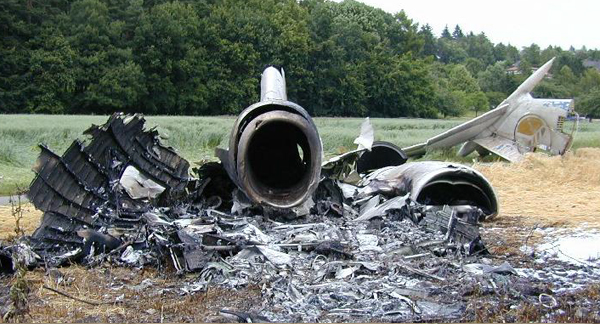
Cessna 208, Dudek Paragliders Solo 21, Fulshear, Texas, December 21, 2021
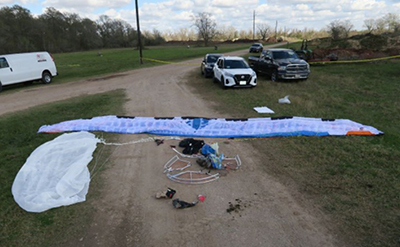
A Cessna 208B airplane collided with a powered paraglider during cruise flight at 5,000 feet mean sea level (msl) in Class E airspace. Based on video evidence, the powered paraglider operator impacted the Cessna’s right wing leading edge, outboard of the lift strut attachment point. The outboard ten feet of the Cessna’s right wing separated during the collision. The Cessna was equipped with a transponder and an ADS-B Out transmitter, which made the airplane visible to the air traffic control system. The operation of the powered paraglider in Class E airspace did not require two-way radio communication with air traffic control, the use of a transponder, or an ADS-B Out transmitter and therefore was not visible to air traffic control. Neither the Cessna nor the powered paraglider were equipped with ADS-B In technology, cockpit display of traffic information, or a traffic alerting system. After considering all the known variables, it is likely that the Cessna pilot did not see the powered paraglider with sufficient time to avoid the collision.
The NTSB attributed the accident to the limitations of the see-and-avoid concept as a method for self-separation of aircraft, which resulted in an inflight collision. Contributing to the accident was the absence of collision avoidance technology on both aircraft.
NTSB accident report: CEN22FA081
Technical Related Lesson(s)
The risk of midair collisions can be reduced in general aviation by supplementing required see-and-avoid responsibilities with real-time traffic information and alerts from ADS-B systems operated in accordance with manufacturer specifications. (Threat Category: Midair Collision)
- See-and-avoid collision protocol is a requirement for VFR flight, but the strategy has inherent limitations, including visual obstructions caused by aircraft structures and limitations of human performance.
- Aural alerting capability is particularly important when pilots are in a high-demand, task-saturated environment such as air tours or operations near airports.
- In this accident, pilots experienced visual obstructions while managing numerous activities that competed with their see-and-avoid responsibilities in a high-traffic area. ADS-B, in theory, would have provided early warning of collision threats, but a variety of technical, operational, and equipage issues resulted in the pilots not receiving visual and/or aural traffic alerts that could have notified one or both of the impending collision.
- Although ADS-B Out is only required for GA aircraft operating within certain airspace, owners/operators who voluntarily install ADS-B Out and In further reduce the risk of having a collision.
- Owners of light GA aircraft can often purchase and install ADS-B Out and In systems for relatively low cost.
- While no one procedure, process, or technology is 100% effective in preventing a midair collision, a combination of preventative measures and best practices can provide the maximum reduction in risk for being involved in a midair collision.
Common Theme Related Lesson
Pilots must be proactive in being visually and electronically observable to other aircraft and, regardless of installed avionics, vigilant in scanning for traffic to reduce the potential for midair collisions. (Common Theme: Human Error)
- It is important that pilots understand the limitations of their ADS-B equipment and do not become overly reliant on ADS-B alerts as a sole means of avoiding collision threats. See-and-avoid techniques remain critical for safe flight.
- The FAA provides a wealth of information about best practices for see and avoid, including pilots learning to move their heads, not just their eyes, due to obstructions in the cockpit.
- In this accident, the NTSB determined that had the Otter pilot moved his head forward to remove a blind spot, he may have seen the Beaver, which was otherwise blocked by the left window post.
For aircraft equipped with ADS-B, pilots must ensure that the technology is properly configured and operational. (Common Theme: Human Error)
- When ADS-B is correctly configured and operating in accordance with manufacturer specifications, pilots receive visual and aural traffic alerts. Aural alerts are particularly important to draw a pilot’s attention to traffic when they might otherwise be task saturated (for example, when operating a sightseeing flight).
- In this accident, both airplanes were equipped with ADS-B Out and In and the necessary displays to show traffic, but only the Beaver was equipped for aural and visual alerts. At the time of the accident, the traffic display application in the Beaver required barometric pressure data input from ADS-B Out of nearby traffic to enable issuance of alerts. A switch configuration error in the Otter’s ADS-B Out avionics prevented the Beaver pilot from receiving alerts about an impending collision.
- In interviews with NTSB investigators, the Otter pilot said he assumed the switch enabling key data, including altitude, to be broadcast by ADS-B Out was in the ON position. Post-crash, the NTSB found that the switch was not turned on, possibly due to recent maintenance work.
